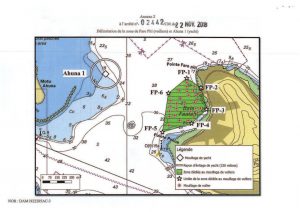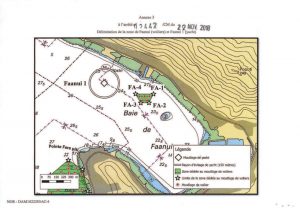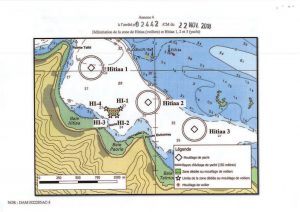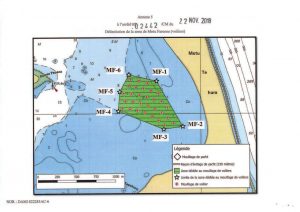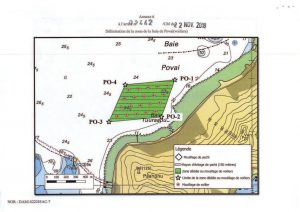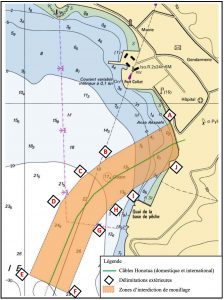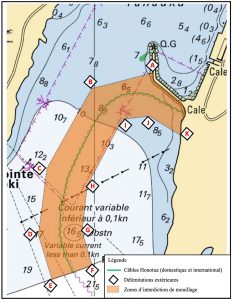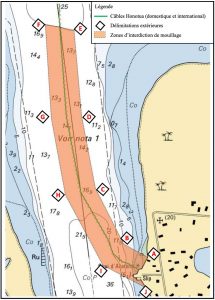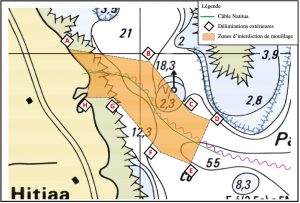ANCRAGE IN LAGONS:
Below are all restrictions on free mooring or dead-body mooring on different islands.
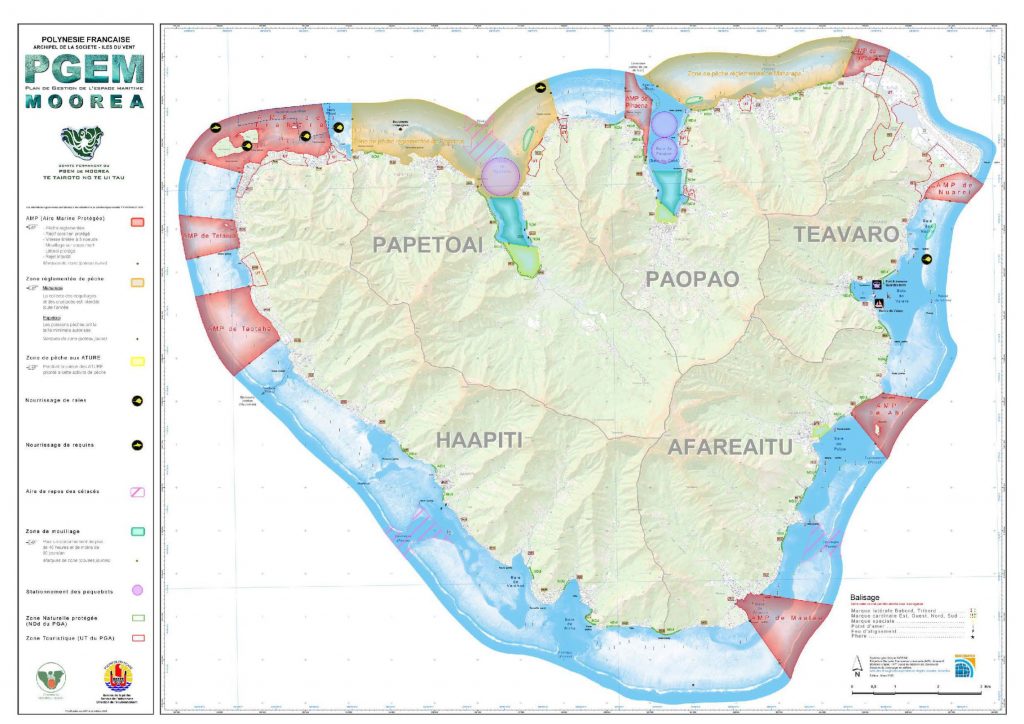 Anchor mooring is only permitted on sand bottoms and for a period of no more than 48 hours. After this period, it must be done in the areas provided for this purpose, and at most for 7 consecutive days. Anchoring in a marina or on a dead body is not time-limited.
Anchor mooring is only permitted on sand bottoms and for a period of no more than 48 hours. After this period, it must be done in the areas provided for this purpose, and at most for 7 consecutive days. Anchoring in a marina or on a dead body is not time-limited.
Check out the PGEM leaflet (2007): Booklet-PGEM-Moorea
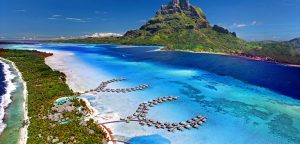 ARRETE No. 2442 CM of November 22, 2018 regulating the mooring of ships in the inland waters of the island of Bora Bora.
ARRETE No. 2442 CM of November 22, 2018 regulating the mooring of ships in the inland waters of the island of Bora Bora.
AIOR DAM1822285AC-1
The President of French Polynesia,
On the report of the Minister of Housing and Land Development, in charge of inter-island transport,
In view of the organic law No. 2004-192 of 27 February 2004 amended to establish the autonomy status of French Polynesia, together law No. 2004-193 of 27 February 2004 complementing the autonomy status of French Polynesia;
In view of Order 650 PR of 23 May 2018 appointing the Vice-President and Ministers of the Government of French Polynesia, and determining their functions;
Given the penal code;
In view of Law 83-581 of 5 July 1983 on the safeguarding of human life at sea, habitability on board ships and the prevention of pollution, together Decree 84-810 of 30 August 1984 amended relating to the safeguarding of human life at sea , pollution prevention, safety and ship certification, as well as the 23 November 1987 ship safety order and its annexed regulations;
In view of Law 61-1262 of 24 November 1961 relating to the police of maritime wrecks, together Decree 61-1547 of 26 December 1961 amended fixing the regime of maritime wrecks;
Given the environmental code of French Polynesia;
In view of the 2004-34 APF deliberation of 12 February 2004 amended on the composition and administration of the public domain in French Polynesia;
In view of the deliberation No. 78-124 of 27 July 1978 amended by the regulation of traffic in the lagoons of French Polynesia;
In view of the request of the municipality of Bora Bora by mail MT/047651/DGS/COM/GTS/MT of 27 October 2018;
Considering the certificate "Blue Flag Label" awarded for the title of the year 2018 to the municipality of Bora Bora;
Considering the imperatives of protecting the environment as well as the safety of navigation and traffic in the inland waters of the island of Bora Bora;
Considering the need to ensure the harmonious coexistence of users in the maritime public domain;
The Council of Ministers, having deliberated in its meeting on 20 November 2018,
Stop it:
CHAPTER I - APPLICABLE GENERAL REGLES IN BORA BORA Island
Article Ler.— Definitions
For the purposes of this order, it means:
parking: immobilizing the vessel in an appropriate technical procedure, for a fixed period of time, and after authorisation duly issued by the competent authority;
anchoring: stopping the vessel in an appropriate manner, either by means of an anchor (ship's apparals) or by a permanent and fixed mooring device (buoy, dead body, ecological anchorage, .),
authority managing the dedicated area: the authority responsible for implementing the provisions of this decree, in particular with regard to management, requests for access to a dedicated area and parking.
Art. 2.— Object
Unless otherwise stated, in the inland waters of the island of Bora Bora, the mooring of vessels of a length greater than or equal to ten (10) metres or whose stay is greater or equal to a duration of twenty-four (24) hours is strictly prohibited outside dedicated to authorized mooring areas.
The delimitation of the dedicated areas is specified in Article 4 . and is included in the plans attached to this order.
The general conditions of use of areas dedicated to authorized anchorage, on anchor or on a mooring facility, are defined by this order.
(e) anchoring any vessel, for any length of time, is strictly prohibited in shipping channels.
Art. 3.- Exemptions
The prohibitions and requirements of this order are not enforceable against vessels and boats on a public service mission or engaged in a person rescue and asset rescue operation, or other vessels in the event of force. Major.
C ITRE II - APPLICABLE REGLES IN DEDIEES ZONES IN MOUILLAGE
Art. 4.- Delimitation of zones - dedicated to authorized mooring
Within the areas dedicated to authorized mooring, ships are anchored or on a light anchorage installation when the area has been authorised by the competent authority.
A - Areas dedicated to anchoring vessels of a reference length of 20 metres or more.
Only anchor anchoring of vessels of a reference length greater than or equal to 20 metres is permitted at the following points:
|
Name |
Longitude |
Latitude |
Avoidane radius |
|
Ahuna 1 |
151- 46,121'0 |
16th 29.246'S |
150 metres |
|
Faanui 1 |
151- 45.449'0 |
16th 28.838'S |
150 metres |
|
Hitiaa 1 |
151- 44.4590 |
16th 27.978'S |
150 metres |
|
Hitiaa 2 |
151- 44,051'0 |
16th 28.223'S |
150 metres |
|
Hitiaa 3 |
151- 43.719'0 |
16th 28,413'S |
150 metres |
|
Toopua 1 |
151- 46.664'0 |
16th 31,361'S |
130 metres |
|
Vaitape 1 |
151- 45,760'0 |
16th 30.838'5 |
150 metres |
|
Vaitape 2 |
151- 45,670'0 |
16th 31,07515 |
150 metres |
B - Area dedicated to anchoring vessels with a reference length of less than 20 metres.
Only the mooring of vessels with a reference length of less than 20 metres is permitted at the following points.
The perimeter of each zone is determined by the reference points indicated by area.
(1) The delimitation of the Nunue Bay area is defined by the following points:
|
Name |
Longitude |
Latitude |
|
BN-1 |
151- 45.180'0 |
16th 30.028'S |
|
BN-2 |
151- 45.129'0 |
16th 36.052'S |
|
BN-3 |
151- 45,159'0 |
16th 30.109'5 |
|
BN-4 |
151- 45.254'0 |
16th 30,119'S |
|
BN-5 |
151-45300'0 |
16th 30.097'5 |
|
BN-6 |
151- 45.307'0 |
16th 30.065'S |
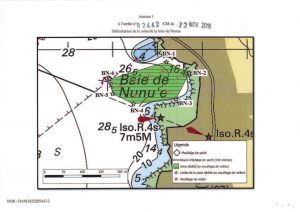 (2) The delimitation of the Fare Piti area is defined by the following points:
(2) The delimitation of the Fare Piti area is defined by the following points:
|
Longitude |
Latitude |
|||
|
FP-1 |
151 degrees |
45.656'0 |
16th |
29.270'S |
|
FP-2 |
151 degrees |
45.575'0 |
16th |
29.322'S |
|
FP-3 |
151 degrees |
45.544'0 |
16th |
29.444'S |
|
FP-4 |
151 degrees |
45.629'0 |
16th |
29.522'S |
|
FP-5 |
151 degrees |
45.796'0 |
16th |
29.571'S |
|
FP-6 |
151 degrees |
45.761'0 |
16th |
29.354'S |
(3) The delimitation of the Faanui area is defined by the following points:
|
Name |
Longitude |
Latitude |
||
|
FA-1 |
151 degrees |
45.165'0 |
16th |
28,899'S |
|
FA-2 |
151 degrees |
45.190'0 |
16th |
28,948's |
|
FA-3 |
151 degrees |
45238'0 |
16th |
28.949'S |
|
FA-4 |
151 degrees |
45,268'0 |
16th |
28.898'S |
In this area, the mooring of ships is strictly limited to five (5) vessels.
The length of stay of the ships in this area may not exceed thirty-six (36) hours.
(4) The delimitation of the Hitiaa area is defined by the following points:
|
Name |
Longitude |
Latitude |
||
|
11I-1 |
151 degrees |
44.2490 |
16th |
28.266'S |
|
HI-2 |
151 degrees |
44,276'0 |
36 degrees |
28.316'S |
|
III-3 |
151 degrees |
44.324'0 |
16th |
28.316'S |
|
HI-4 |
151 degrees |
44.355'0 |
16th |
28.266'S |
In this area, the mooring of ships is strictly limited to five (5) vessels.
The length of stay of the ships in this area may not exceed thirty-six (36) hours.
(5) The delimitation of the Motu Fareone area is defined by the following points:
|
Name |
Longitude |
Latitude |
||
|
MF-1 |
151 degrees |
42.319'0 |
16th |
31.772'S |
|
MF 2 |
151 degrees |
42.130'0 |
16th |
32.091'S |
|
MF-3 |
151 degrees |
42267'0 |
16th |
32111'S |
|
MF-4 |
151 degrees |
42.595'0 |
16th |
31.983'S |
|
MF-5 |
151 degrees |
42.585'0 |
16th |
31.846'S |
|
MF-6 |
151 degrees |
42.518'0 |
16th |
31.726'S |
(6) The delimitation of the area south of Povai Bay is defined by the following points:
|
Name |
Longitude |
Latitude |
||
|
P0.1 |
151 degrees |
44.442'0 |
16th |
31410'S |
|
P0.2 |
151 degrees |
44,520'0 |
16th |
31,618'S |
|
P0-3 |
151 degrees |
44.8230 |
16th |
31,645'S |
|
P0'-4 |
151 degrees |
44,728'0 |
16th |
31.437S |
(7) The delimitation of the area west of the Toopua motu is defined by the following points:
|
Name |
Longitude |
Latitude |
|||
|
T0-1 |
151 degrees |
46313'0 |
16th |
30.623'S |
|
|
' |
TO.2 |
151 degrees |
46.343'0 |
16th |
30.942'S |
|
T0-3 |
151 degrees |
46.4080 |
16th |
31.090'S |
|
|
T0-4 |
151 degrees |
46.5620 |
16th |
31.236'S |
|
|
TO.5 |
151 degrees |
46.707'0 |
16th |
31.088'S |
|
|
T0-6 |
151 degrees |
46.4010 |
16th |
30.870'S |
|
|
TO.7 |
151 degrees |
46.372'0 |
16th |
30.619'S |
|
The geographic coordinates defined in Article 4 are placed in the WGS84 geodesic system in decimal degrees and minutes.
The delimitation of the authorized dedicated mooring areas is represented in annexes of this decree, available to the Polynesian Directorate of Maritime Affairs (DPAM) and on the website www.maritime.gov.pf and www. ervice-public. p f/dp am
Art. 5.— Signage of mooring areas
The signage for each area dedicated to the authorized mooring area is put in place by the area manager and must comply with the requirements of the authority responsible for the safety of navigation and traffic in inland waters.
The technical signalling device is adapted to the nature of the seabed.
The authorized manager of the area dedicated to authorized mooring is obliged to inform the competent authority without delay of any changes in the signalling situation.
Art. 6.— Access and navigation rules within mooring areas
Access to dedicated areas is permitted for vessels in a state of navigation, as well as those in danger or in a state of damage.
Access to dedicated areas by vessels in danger or in a state of damage, is allowed only for a limited stay, justified by the circumstances.
Access and traffic within areas dedicated to authorized anchorage are carried out in accordance with navigation rules, including those set by international regulations to prevent collisions at sea.
Within these dedicated areas, the maximum speed of ships is set at 3 knots.
Except in case of force majeure, ships are only allowed to move within the dedicated area to access or leave a berth.
Art. 7.— Entry and Departure Statement
Any vessel calling in one of the areas dedicated to authorized anchorage is required, upon arrival, to make itself known to the authorized manager and to make a declaration of entry by any appropriate means (telephone, fax, e-mail, VHF) for Transmit:
A photocopy of the ship's documents (registration certificate, identification of the ship's flag and owner);
A photocopy of the owner's passport or, if necessary, the ship's user;
The specific contact details of the owner, or if any, of the ship's user (phone numbers, email);
The scheduled date for departure from the mooring area. If this date is changed, an adjustment statement is made without delay to the authorized manager of the authorized area;
A departure statement is made before the ship is finally discharged from the dedicated area.
Art. 8.— Use of authorized mooring areas
The master of any vessel must ensure that his vessel, at all times and under any circumstances, does not cause any damage to other vessels or interfere with the use of the mooring area authorized by other users.
If necessary, all precautions, manoeuvres or movements, location changes prescribed by the qualified manager, must be respected or executed, especially when they are deemed necessary to facilitate the movement of other vessels or ensure the safety of navigation and traffic in the inland waters of the island of Bora Bora.
Art. 9.— Hygiene and pollution
Ships anchored in one of the areas dedicated to authorized mooring may not discharge, dump or allow their household waste and waste of any kind to flow into the water, or contaminated or oil-laden water, oils or products. Toxic. Any rejection to the sea is strictly forbidden.
All waste must be deposited in onshore facilities provided for this purpose. The discharge of wastewater is subject to special regulations.
It is forbidden to carry out any work on ships at anchor in areas dedicated to authorized mooring.
Repair, fairing operations, product applications or paints.
Art. 10.— Removing marine wrecks and abandoned ships
Any vessel staying in the areas dedicated to authorized anchorage must be kept in a good state of maintenance, buoyancy and safety.
If the authorized manager finds a wreck or a vessel is in a clear state of abandonment or lack of maintenance, and has, in whole or in part, a dangerous nature for navigation, fishing or the environment, access to a port or stay in a port, which may sink or cause damage to ships, surrounding structures or the environment, it informs the competent authority as soon as possible to proceed with the owner's notice to take any necessary to remove the dangerous nature of the vessel.
In the event of inaction by the vessel owner within the allotted time, the competent authority automatically proceeds with the operations necessary at the owner's expense and risk to put an end to the risk of danger or damage to the public maritime domain.
For the removal of the wreckage, the owner of the vessel complies with the requirements issued by the competent authority.
Art. 11.— Prohibition of the practice of water, water or underwater activities in the perimeter of areas dedicated to authorized mooring.
Within the boundaries of the areas dedicated to authorized mooring, the practice of any nautical, aquatic or underwater activity is strictly prohibited for reasons of navigational safety.
Art. 12.— Public display and information
This order and its annexes regulating the mooring of ships in the inland waters of Bora Bora Island are the subject of information by way of signage in the town hall, and a signage by information sign in French, in Tahitian and in English, located on the outskirts of dedicated areas, close enough, and in an appropriate place to ensure its accessibility and visibility by all users.
Art. 13.— Sanctions
Without prejudice to the penalties relating to the preservation of the public domain, and in accordance with Article 131-13 of the Penal Code:
(1) Is punished with the fine for 4th class tickets:
Any vessel mooring referred to Article 2 outside the authorized mooring areas defined in Article 4, unless authorized;
Any vessel mooring of a reference length greater than or equal to 20 metres outside the areas reserved for them and which are defined in Article 4-A;
Any vessel mooring with a reference length of less than 20 metres outside the areas reserved for them and which are defined in Article 4-B;
Any violation of the vessel traffic rules under article 6.
(2) The fine for 2nd class tickets is punishable:
Failing to make Article 7 statements;
Any refusal to carry out the precautions or requirements in the second paragraph of Article 8;
All work or operations carried out on vessels in violation of Article 9;
One of the activities prohibited by Article 11 in the Article 4 areas;
(3) The release, release or discharge of any pollutant in the waters is punishable by the French Polynesian Environmental Code (LP). 3131-1).
Art. 14.— Violations Report
Without prejudice to the powers exercised by officers and judicial police officers and sworn officers of the commune of Bora Bora, violations of the provisions of this order are found by minutes drawn up by the officers Polynesian Maritime Affairs Directorate.
Art. 15.— The Minister of Housing and Land Development, in charge of inter-island transport, the Minister of Green Economy and the Domain, in charge of mines and research, the Minister of Culture and the Environment, in charge of crafts, and the Minister of Equipment and Land Transport are each responsible for the execution of this order, which will be published in the Official Journal of French Polynesia.
Made in Papeete, November 22, 2018.
For the absent President:
The Vice-President,
Teva ROHFRITSCH.
By the President of French Polynesia:
The Minister of Housing
planning,
Jean-Christophe BOUISSOU.
The Minister of the Green Economy
and the field,
Tearii ALPHA.
For the Minister of Culture
and the absent environment:
The Minister of Modernization
Administration,
Tea FROGIER priscille.
For the Minister of Equipment
and land transport absent:
The Minister of Housing
planning,
Jean-Christophe BOUISSOU.
Official source: http://lexpol.cloud.pf/document.php?document=355647&deb=23226&fin=23236&titre=QXJyw6p0w6kgbsKwIDI0NDIgQ00gZHUgMjIvMTEvMjAxOA
The use of these dead bodies is to date free and made available by the Environment Directorate.
 Chapter 9: ANCRAGE OF THE SHIP
Chapter 9: ANCRAGE OF THE SHIP
Article 27: Formalities
Upon arrival, the ship's captain must contact the captaincy of Fakarava (Municipal Police) to indicate his position and to inquire about the regulations specific to the lagoons of the commune as well as the health and protection measures species and the environment in general.
Article 28: Implementation
Wetting on a sandy bottom, in a marina or on a dead body is not time-limited. The ship must be fit to sail. Otherwise, it is equated with a floating dwelling, and regulated as such by Order 1211 AU amended of August 24, 1983.
Ship mooring is permitted in The ZM-rated mooring areas on the MSP plan of each atoll.
Note that it is the position of the anchor and not that of the ship that attests to the location of the berth.
Article 29: Prohibited Activities
Anchoring, for any length of time, is strictly prohibited in marked navigation channels and passes, except in cases of force majeure. Mooring is strictly prohibited on the coral and within 200 metres of the shore. Vessels that are not used in fishing in fish parks must move away from these parks so as not to disturb this activity.
Article 30: Bonds
Ships with toilets must be equipped with a clean system and biodegradable detergents as of January 1, 2008. No waste, even a biodegradable waste, should be thrown into the water.
Chapter 6: DIME IN SCAPHANDRE AUTONOMR
Article 18 Definition
It is a tourist activity for which one or more providers offer dives in autonomous diving, for commercial or non-commercial purposes and which requires the preservation of the sites.
Article 19: Implementation
The sites frequented for scuba diving are declared to the standing committee and to the deputy mayor of the associated municipality where the dive sites are located. Each site is marked by a buoy placed at the time of the dives, except in the case of drift dives.
The boat that brings the divers to the site is necessarily moored to a dead body that materializes the diving area, except in the case of a drift dive where it follows the divers from the surface. In both cases, the regulatory diving pavilion must be visible on site.
Article 20: Site Operations
Commercial enterprises, associations, clubs organising, framing or hosting diving activities are required to take all the following arrangements:
to make divers aware of the possible risks,
inform divers, who accompany them, of the regulations applicable in the area,
enforce these regulations,
ensure the cleanliness of the site and its general respect,
Avoid contact with the bottom or walls.
Dives must be organised in accordance with the rules in force, including the safety of divers.
Article 21: How the business works
The operation of a site can only be done after the accession to a charter defining the conditions of operation of such an activity. Only providers who have signed the charter can offer so-called bottle dives.
Due to the characteristics of the environment (current, presence of sharks...), the dive must be supervised by a well-known professional who knows the scene perfectly.
Article 22: Prohibited Activities
Fishing, collecting shells and corals, and feeding fish are strictly prohibited at dive sites.
Attention! New anchor restriction zones have been defined to protect the NATITUA cable that supplies the archipelagos with fibre optics. Failure to comply with these areas exposes you to a 5th class ticket.
Article 1. -Object
It is created in the maritime space on the outskirts of the commune of Rangiroa, Nuku Hiva, Hiva Oa and Tahiti (Hitia'a) an no-go zone at anchor to protect the submarine cables. The coordinates of this area are defined in Article 2 below.
Article 5. -Sanctions
Without prejudice to the public domain conservation sanctions, and in accordance with Article 131-13 of the Penal Code, the offences in this order expose the perpetrators to the penalties and penalties provided for 5th class tickets.
Article 6. -Finding of offences
Without prejudice to the powers exercised by officers and judicial police officers, violations of the provisions of this order are found by minutes drawn up by the authorized and sworn officers of the Polynesian Directorate of maritime affairs.






